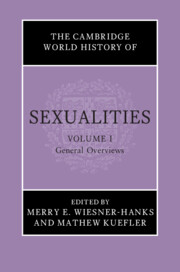Book contents
- The Cambridge World History of Sexualities
- The Cambridge World History of Sexualities
- The Cambridge World History of Sexualities
- Copyright page
- Contents
- Figures in Volume I
- Contributors to Volume I
- Editors’ Preface to the Series
- 1 The History of the History of Sexuality
- 2 The History of Sexuality and Anthropology
- 3 The History of Sexuality and Women’s History
- 4 The History of Sexuality and LGBTQ+ History
- 5 The Impact of Sigmund Freud on the History of Sexuality
- 6 Michel Foucault’s Influence on the History of Sexuality
- 7 Queer Theory and the History of Sexuality
- 8 The Sexual Body in History
- 9 Marriage and Families in the History of Sexuality
- 10 Class in the History of Sexuality
- 11 Sexuality and Race: Representations, Regulations, and Sentiments
- 12 Male Homoerotic Relations in History
- 13 Desire, Love, and Sex between Women in Global History
- 14 Trans and Gender Variant Sexualities in History
- 15 The Sale of Sex in History
- 16 Sexual Violence in History
- 17 Sexual Science in History
- 18 Sexuality and Emotion
- 19 Erotic Art in World History
- 20 Erotic Literature in History
- 21 The Material Culture of the History of Sexuality
- 22 Public History and Sexuality
- Index
- CONTENTS TO VOLUMES II, III, AND IV
- References
20 - Erotic Literature in History
Published online by Cambridge University Press: 26 April 2024
- The Cambridge World History of Sexualities
- The Cambridge World History of Sexualities
- The Cambridge World History of Sexualities
- Copyright page
- Contents
- Figures in Volume I
- Contributors to Volume I
- Editors’ Preface to the Series
- 1 The History of the History of Sexuality
- 2 The History of Sexuality and Anthropology
- 3 The History of Sexuality and Women’s History
- 4 The History of Sexuality and LGBTQ+ History
- 5 The Impact of Sigmund Freud on the History of Sexuality
- 6 Michel Foucault’s Influence on the History of Sexuality
- 7 Queer Theory and the History of Sexuality
- 8 The Sexual Body in History
- 9 Marriage and Families in the History of Sexuality
- 10 Class in the History of Sexuality
- 11 Sexuality and Race: Representations, Regulations, and Sentiments
- 12 Male Homoerotic Relations in History
- 13 Desire, Love, and Sex between Women in Global History
- 14 Trans and Gender Variant Sexualities in History
- 15 The Sale of Sex in History
- 16 Sexual Violence in History
- 17 Sexual Science in History
- 18 Sexuality and Emotion
- 19 Erotic Art in World History
- 20 Erotic Literature in History
- 21 The Material Culture of the History of Sexuality
- 22 Public History and Sexuality
- Index
- CONTENTS TO VOLUMES II, III, AND IV
- References
Summary
Fervent expressions of erotic desire, the beauty and terror of passionate arousal, are here uncovered in religious texts, creation myths, ‘arts of love’, poetry and fiction across four millenia and twenty-four cultures. The chapter starts with an example known throughout the world: the Hebrew love poem preserved as The Song of Songs or Song of Solomon, translated into many languages including German, Chinese and Yoruba, emulated by Oscar Wilde and Toni Morrison. It argues that the Song and related literature are significant for the frank celebration of mutuality and orgasm, and the psychological understanding of cruelty and loss, rather than for their supposed spiritual meanings. These central themes are traced back to the most ancient narratives of primal copulation (including the Sumerian Epic of Gilgamesh) and forward to intensely sexual episodes in Milton, Goethe, James Joyce, D. H. Lawrence and women authors from Mediaeval mystics up to the present. A closely related literary genre turns love-making into an art form, cultivated for its own sake: examples come from ancient Egypt and Rome, the Indian Kama Sutra, the Arabic Perfumed Garden, the Modi of Aretino in Renaissance Italy, and French, Chinese and Japanese novels of sexual instruction and adventure.
Keywords
- Type
- Chapter
- Information
- The Cambridge World History of Sexualities , pp. 443 - 466Publisher: Cambridge University PressPrint publication year: 2024

